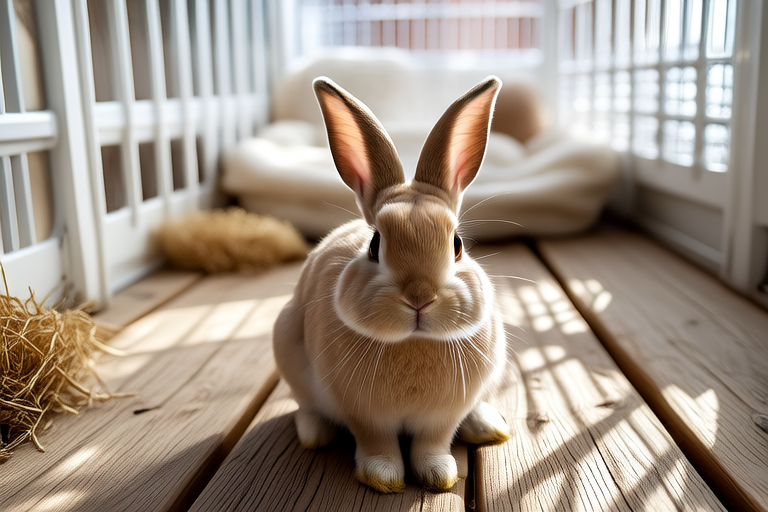From Barn to Bedroom: Transforming Spaces for Your New Lop Rabbit Buddy
Welcome to the world of lop rabbit companionship! Transitioning your lop rabbit from a barn to a bedroom can be a rewarding experience for both you and your furry friend. This comprehensive guide will help you understand the essential steps and considerations to ensure a smooth transition and a happy, healthy life indoors.
Understanding the Needs of Your Lop Rabbit
Lop rabbits, known for their floppy ears, are gentle and affectionate animals that thrive in environments where they feel safe and comfortable. When moving your lop rabbit from an outdoor barn to an indoor bedroom, it’s crucial to consider their physical and emotional needs. Indoor living provides a more controlled environment, protecting your rabbit from predators, harsh weather, and potential diseases. It also allows for closer bonding and interaction with your family.
Space Requirements
The first step in creating a suitable indoor space is ensuring adequate room for your lop rabbit. A minimum of 8 square feet per rabbit is recommended, but more space is always better. This area should include a living space, sleeping quarters, and a litter box. The living space should be large enough for your rabbit to move around freely, stretch out, and engage in natural behaviors such as hopping and digging.
Consider placing the rabbit’s living area away from high-traffic areas in your home to minimize stress. If possible, dedicate a quiet corner or a separate room for your rabbit. This setup allows them to have their own space without feeling overwhelmed by household activities.
Safety Measures
Ensuring the safety of your lop rabbit is paramount. Rabbits are curious creatures and can easily get into trouble if given the opportunity. To prevent accidents, cover all electrical cords with cord covers or place them out of reach. Secure any furniture with wobbly legs to avoid tipping over when your rabbit hops on them. Additionally, install childproof locks on cabinets and drawers to keep your rabbit from accessing potentially harmful items.
It’s also important to provide your rabbit with safe toys and chews to satisfy their natural urge to gnaw. Wooden blocks, cardboard boxes, and hay balls are excellent options. These toys not only entertain your rabbit but also help maintain their dental health by providing necessary chewing opportunities.
Appropriate Bedding
Selecting the right bedding is essential for your lop rabbit’s comfort and well-being. Avoid cedar and pine shavings, as these can cause respiratory issues. Instead, opt for paper-based bedding or recycled newspaper products. These materials are dust-free and provide excellent absorbency while being safe for your rabbit to nibble on.
To enhance comfort, add soft blankets or towels for your rabbit to snuggle in. Make sure the bedding is changed regularly to prevent odors and bacterial growth. A clean and fresh living environment promotes good health and hygiene for your rabbit.
Temperature Control
Rabbits are sensitive to extreme temperatures, so maintaining a consistent indoor climate is vital. Ideally, the temperature should be kept between 60°F and 75°F (15°C to 24°C). Use fans or air conditioning during hot summer months to prevent heatstroke, and provide extra bedding or a heated pad during colder winter periods.
Adequate ventilation is also important to ensure proper air circulation. Place your rabbit’s living area near a window or use a small fan to circulate fresh air. However, make sure the window is securely screened to prevent drafts and potential escapes.
Enrichment Activities
Boredom can lead to destructive behavior in rabbits, so it’s essential to provide plenty of mental and physical stimulation. Incorporate various toys and activities into your rabbit’s daily routine to keep them engaged and entertained.
- Foraging Toys: Hide treats within hay balls or cardboard tubes to encourage natural foraging behaviors.
- Tunnels and Caves: Create tunnels using cardboard boxes or purchase commercially available rabbit tunnels. Providing caves or hideaways gives your rabbit a sense of security and privacy.
- Exercise Time: Allow your rabbit supervised time outside of their enclosure each day. A rabbit-proofed room or a secure outdoor pen provides ample space for exercise and exploration.
- Interactive Play: Spend quality time with your rabbit by playing games or simply interacting through petting and grooming.
Meeting Emotional and Physical Needs
Your lop rabbit’s emotional and physical needs must be met to ensure a happy and healthy life indoors. Regular exercise, social interaction, and mental stimulation are crucial for your rabbit’s well-being. Spend time each day interacting with your rabbit, offering treats, and engaging in play. This bond-building time strengthens your relationship and helps your rabbit feel secure and loved.
Physical health is equally important. Schedule regular veterinary check-ups to monitor your rabbit’s overall health. Maintain a balanced diet consisting of hay, fresh vegetables, and a limited amount of pellets. Provide access to clean water at all times. Groom your rabbit regularly to prevent hairballs and promote healthy skin and coat.
Benefits of Indoor Living for Rabbits
Moving your lop rabbit indoors offers numerous benefits, both for your rabbit and for you as a pet owner. Indoor living protects your rabbit from predators, harsh weather conditions, and parasites. It also allows for closer bonding and interaction, fostering a stronger relationship between you and your pet.
Indoor rabbits tend to live longer and healthier lives due to the controlled environment. They are less likely to suffer from injuries or illnesses caused by outdoor hazards. Moreover, keeping your rabbit indoors ensures they receive proper care and attention, leading to a happier and more fulfilling life.
Conclusion
Transitioning your lop rabbit from a barn to a bedroom requires careful planning and consideration of their physical and emotional needs. By providing ample space, ensuring safety, selecting appropriate bedding, controlling temperature, and offering enrichment activities, you can create a loving and stimulating environment for your new indoor rabbit companion. Embrace this journey of bonding and care, and enjoy the rewarding experience of sharing your home with a lop rabbit.
